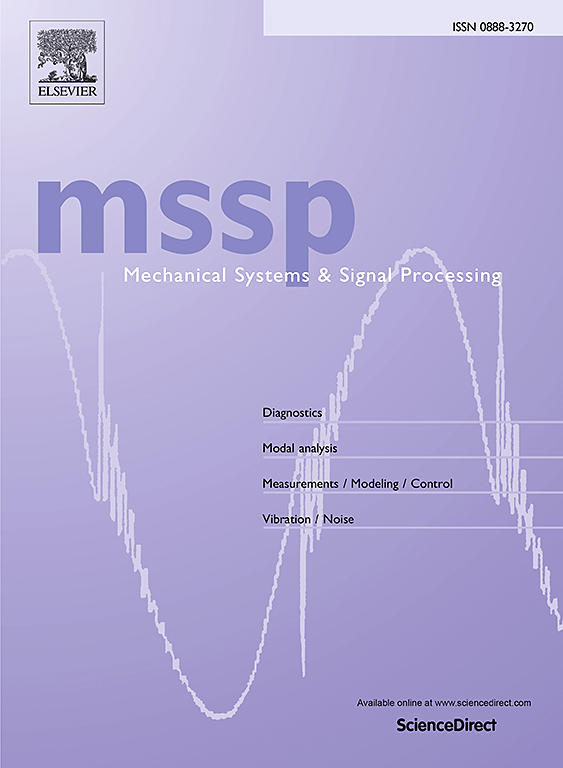Accurate structural parameter identification of individual layers of complex multilayer composites for improved simulations using wave and finite element methodology
IF 8.9
1区 工程技术
Q1 ENGINEERING, MECHANICAL
引用次数: 0
Abstract
Accurate real material modeling is essential for structural dynamic analysis and design. Reliable structural parameters estimation, involving geometric and material parameters, is a key prerequisite, yet many existing methods primarily address homogenized material properties, which is inadequate for multilayer composites with complex geometrical core. To this end, this paper introduces a robust wave-based approach to structural parameter identification of individual layers, using only full-field displacement data. Specifically, the Algebraic K-Space Identification 2D technique (AKSI 2D) initially extracts wavenumber space (k-space) from measured structural responses, while surrogate optimization subsequently aligns this experimental k-space with the Wave Finite Element Method (WFEM)-derived numerical k-space to estimate structural parameters. The superiority of the proposed identification method stems from: (1) the ability of the AKSI 2D to automatically and accurately identify wavenumbers in any wave propagation direction from displacement fields on 2D grids, even in noisy environments, eliminating the need for complex filtering and specific point layouts; (2) the capacity of the WFEM in modeling wave propagation within multilayer structures with complex geometries, using unit cell-based operations within finite element software; and (3) the efficiency of the surrogate optimization in solving high-dimensional problems by finding the global minimum with high computational efficiency. To validate the accuracy of the proposed method, the structural parameters of each layer in two numerical cases, a four-layer laminated carbon fiber panel and a kelvin cell-based sandwich composite panel, are estimated. The inverted structural parameters show good agreement with the reference values, with an averaged relative error of less than 3.5%, even when a high level of white noise is added to the simulated displacement field. In addition, the structural parameters of a real parallelogram core sandwich panel is updated experimentally. These studies confirm that the proposed approach aligns with the intuitive decision-making of structural engineers for material characterization and modeling, offering adaptability for diverse structural design tasks.
复杂多层复合材料各层结构参数的精确识别,改进了用波和有限元方法模拟的方法
准确的真实材料建模对于结构动力分析和设计至关重要。可靠的结构参数估计,包括几何参数和材料参数,是一个关键的先决条件,但许多现有的方法主要针对均匀材料性能,这是不够的多层复合材料具有复杂的几何核心。为此,本文介绍了一种鲁棒的基于波的方法,仅使用全场位移数据来识别单个层的结构参数。具体来说,代数k空间识别2D技术(AKSI 2D)首先从测量的结构响应中提取波数空间(k空间),而代理优化随后将该实验k空间与波浪有限元法(WFEM)衍生的数值k空间对齐,以估计结构参数。该识别方法的优越性在于:(1)即使在噪声环境下,AKSI 2D也能够自动准确地从二维网格上的位移场中识别任何波传播方向的波数,从而消除了复杂滤波和特定点布局的需要;(2)在有限元软件中使用基于单元格的操作,WFEM模拟具有复杂几何形状的多层结构中的波传播的能力;(3)计算效率高的求全局最小值方法求解高维问题的代理优化效率。为了验证所提方法的准确性,对四层复合碳纤维板和开尔文腔夹层复合材料板两种数值情况下的每层结构参数进行了估计。在模拟位移场中加入高水平白噪声时,反演结构参数与参考值吻合较好,平均相对误差小于3.5%。此外,还对实际平行四边形芯芯夹芯板的结构参数进行了实验更新。这些研究证实,所提出的方法符合结构工程师对材料表征和建模的直觉决策,为各种结构设计任务提供了适应性。
本文章由计算机程序翻译,如有差异,请以英文原文为准。
求助全文
约1分钟内获得全文
求助全文
来源期刊

Mechanical Systems and Signal Processing
工程技术-工程:机械
CiteScore
14.80
自引率
13.10%
发文量
1183
审稿时长
5.4 months
期刊介绍:
Journal Name: Mechanical Systems and Signal Processing (MSSP)
Interdisciplinary Focus:
Mechanical, Aerospace, and Civil Engineering
Purpose:Reporting scientific advancements of the highest quality
Arising from new techniques in sensing, instrumentation, signal processing, modelling, and control of dynamic systems
 求助内容:
求助内容: 应助结果提醒方式:
应助结果提醒方式:


